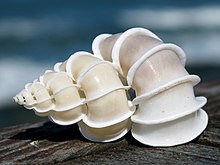Wentletrap
| Wentletrap | |
|---|---|
 |
|
| A shell of Epitonium scalare | |
| Scientific classification | |
| Kingdom: | Animalia |
| Phylum: | Mollusca |
| Class: | Gastropoda |
| (unranked): |
clade Caenogastropoda clade Hypsogastropoda |
| Superfamily: | Epitonioidea |
| Family: |
Epitoniidae Berry, 1910 (1812) |
| Type genus | |
|
Epitonium P. F. Röding, 1798 |
|
| Diversity | |
| about 630 species | |
| Synonyms | |
|
|
clade Hypsogastropoda
informal group Ptenoglossa
Wentletraps are small, often white, very high-spired, predatory or ectoparasitic sea snails, marine gastropod mollusks in the family Epitoniidae.
The word wentletrap originated in Dutch (wenteltrap), and it means spiral staircase. These snails are sometimes also called "staircase shells", and "ladder shells".
The Epitoniidae family belongs to the superfamily Epitonioidea, which also includes the Janthinidae (the pelagic purple snails) and the family Nystiellidae, all part of the informal group Ptenoglossa. Epitoniidae is a rather large family, with an estimated number of species about 630.
Wentletraps inhabit all seas and oceans worldwide, from the tropical zones to the Arctic and Antarctic zones.
Most species of wentletrap are white, and have a porcelain-like appearance. They are notable for their intricately geometric shell architecture, and the shells of the larger species are prized by collectors.
The more or less turret-shaped shell consists of tightly-wound (sometimes loosely coiled), convex whorls, which create a high, conical spiral. Fine or microscopic spiral sculpture (also called "striae") is present in many species. The shells sometimes feature an umbilicus. Wentletrap shells have a roundish or oval aperture, but its inner lip is often reduced to strip of callus. The round and horny operculum is and fits the aperture tightly. Most of the species in the family are small to minute, although some are larger, and overall the adult shell length in the family varies between 0.6 and 11.7 cm.
...
Wikipedia
